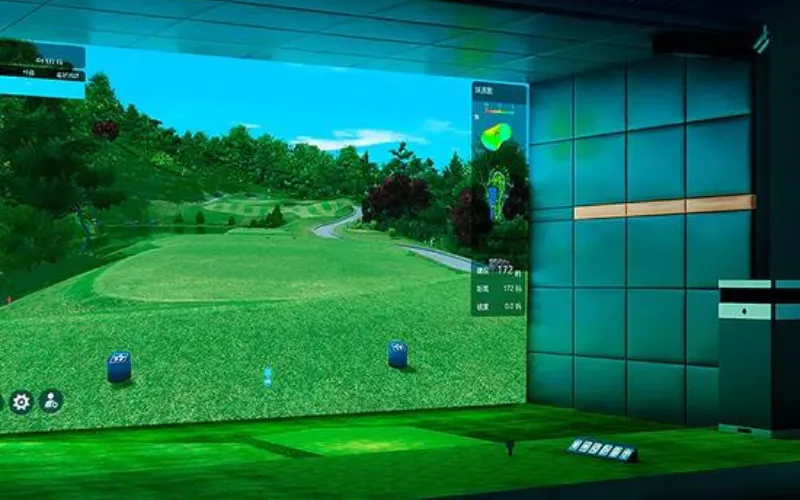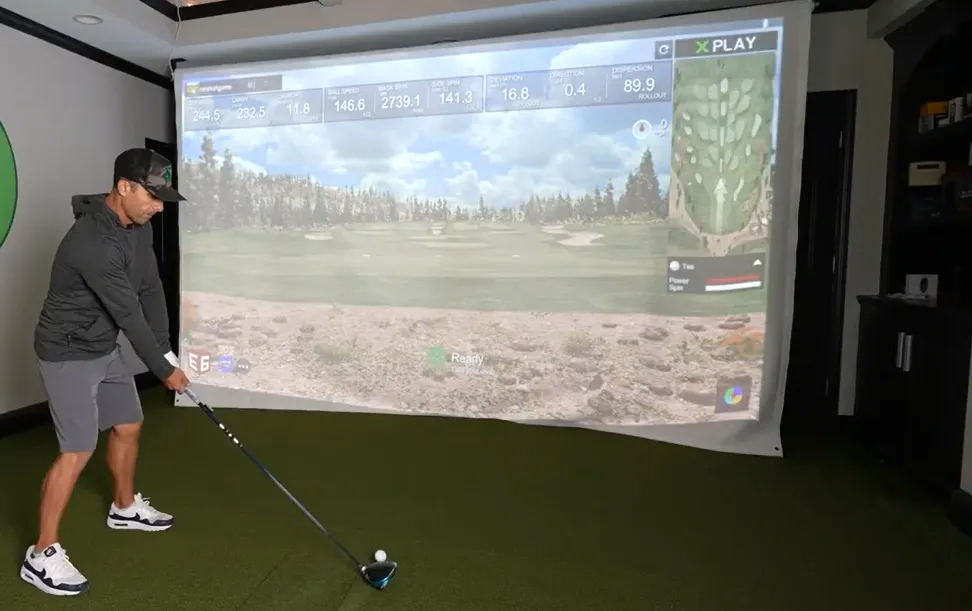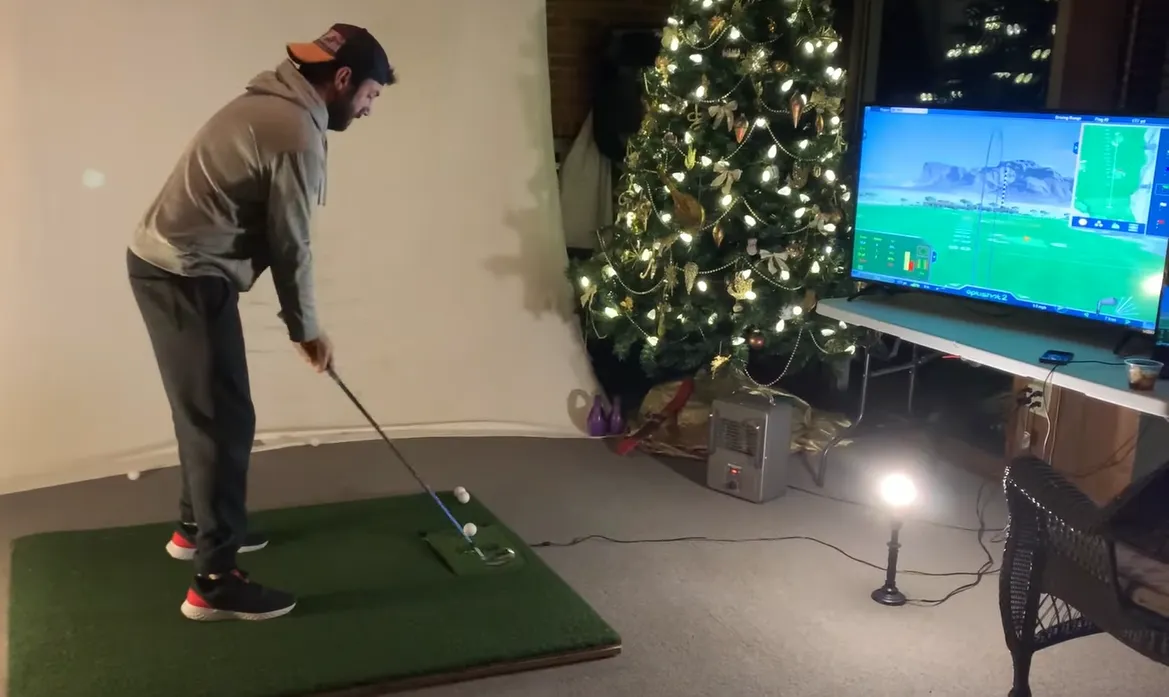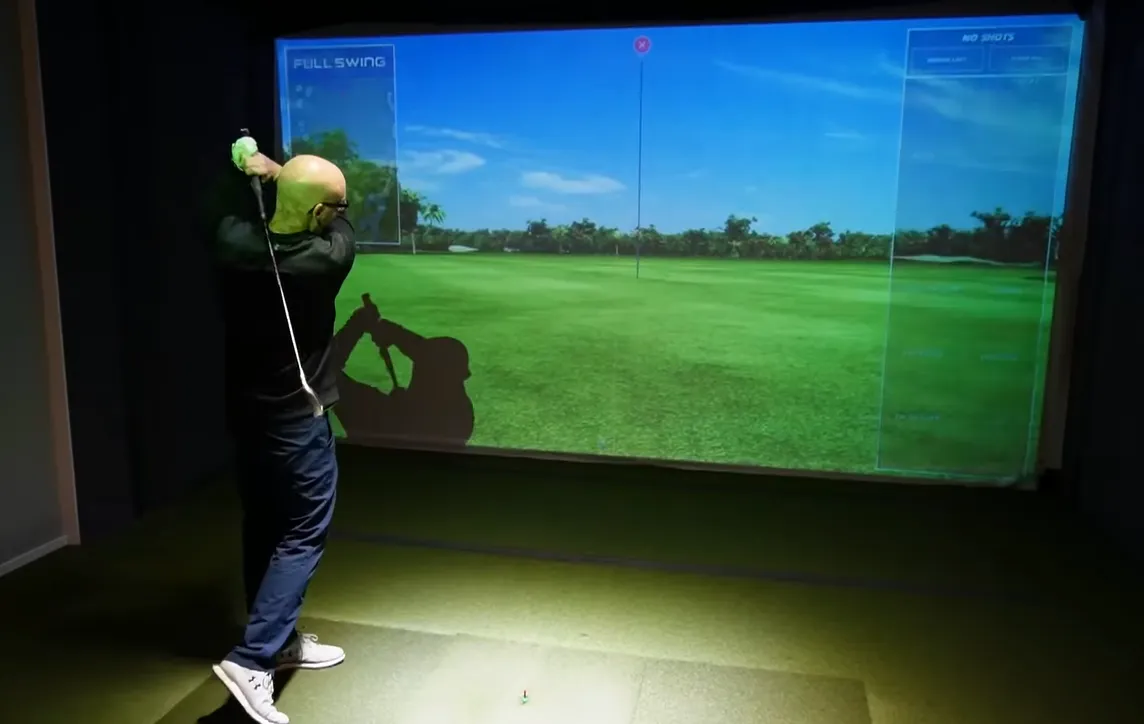The ability to play a full round of golf or work on your swing without leaving the house has made home golf simulators a popular addition for enthusiasts of all skill levels. Modern systems offer a highly realistic and data-rich experience, moving far beyond simple video games. They provide a practical way to play and practice year-round, regardless of weather, and deliver valuable feedback on every shot.
This guide offers a purely informational, expert-driven breakdown of the technology, what to consider before choosing a system, and an objective analysis of several models available on the market. The goal is to provide a complete picture of the current landscape, enabling you to understand which solution aligns with your space, budget, and golfing objectives. While some systems can be complex, many modern options provide an accessible entry point into the world of virtual golf, a field that shares technological passion with pursuits like advanced sim racing games.
Comparing Top Home Golf Simulators of 2025
This table provides a high-level comparison of the products analyzed in this guide. Note that the “Aaikeec Impact Screen” is a component, not a full simulator system, and is included for context within a complete setup.
| Feature | Aaikeec Impact Screen | SwingLogic SLX MicroSim | OptiShot 2 | Phigolf 2 | SMARTGOLF AI-X |
| Technology Type | N/A (Woven Polyester) | Accelerometer/Gyro Sensor | High-Speed Infrared | 9-Axis Motion Sensor | 9-Axis Motion Sensor |
| Primary Use | Ball Impact Surface | Swing Stick Simulator | Mat-Based Simulator | Swing Stick/Club Sensor | AI Swing Trainer & Sim |
| Key Metrics | N/A | Club Speed, Face Angle, Tempo, Path | Club Speed, Face Angle, Path, Carry | Head Speed, Tempo, Path, Distance | Head Speed, Swing Path, Tempo, Face Angle |
| Software Included | None | E6 Connect (iOS) | OptiShot Orion | Phigolf App | SmartGolf AI App |
| Platform | N/A | iOS, PC | Windows | iOS, Android | iOS, Android |
| Use w/ Real Balls? | Yes | Foam ball only | No/Foam ball advised | No (Swing Stick) | No (Swing Stick) |
| Ideal User Level | DIY Builders | Beginner | Beginner/Entertainment | Beginner/Intermediate | Intermediate/Data-Focused |
| Unique Feature | High-density weave for durability | Attaches to real clubs | 15 included real-world courses | Access to WGT & E6 Connect | AI-powered swing analysis and vocal feedback |
How to Choose a Golf Simulator for Your Home
Selecting the right golf simulator involves more than just picking a product. It requires an assessment of your goals, budget, and physical space. Understanding these key elements will ensure your investment is a rewarding one.
Understanding Simulator Technology Types
Golf simulators use different technologies to capture club and ball data.
- Infrared: Sensors emit light to track the club head as it passes through the hitting zone. This is common in budget-friendly, mat-based systems like the OptiShot 2. They are effective for swing path and speed but do not directly measure ball data.
- Photometric: High-speed cameras capture thousands of images per second at impact to measure ball characteristics like launch angle, speed, and spin. This technology is used in many commercial and high-end launch monitors.
- Doppler Radar: Radar-based systems track the ball after it leaves the club, measuring its flight to calculate data. This is highly accurate, especially for ball speed and distance, and is the technology used in professional-grade launch monitors.
- Sensor-Based: Many accessible simulators use a 9-axis motion sensor (accelerometer and gyroscope) attached to a club or a practice stick. These are excellent for measuring the swing itself—path, speed, tempo—but they calculate, rather than directly measure, ball flight.
Key Data Metrics: What to Look For
Different simulators provide different data points. Critical metrics include:
- Ball Speed: The velocity of the ball immediately after impact. A primary factor in total distance.
- Club Head Speed: The speed of the club head at impact.
- Launch Angle: The vertical angle at which the ball takes off.
- Spin Rate: The amount of backspin on the ball, which affects carry distance and roll.
- Swing Path & Face Angle: These metrics determine shot shape (draw, fade, hook, slice).
Space and Environment Considerations
The single most important constraint for a home golf simulator is space. You need enough room to swing a driver without any risk of hitting walls or the ceiling.
Expert Insight: Before purchasing any equipment, take your driver into the intended room and perform slow, full practice swings. This is the only true way to know if your space is adequate.
For a detailed breakdown of spatial requirements, a dedicated analysis on ceiling height for a golf simulator is an essential resource. As a general rule, a space that is at least 15 feet deep, 12 feet wide, and 9-10 feet high is a comfortable starting point for most systems.
Software and Course Compatibility
The simulator hardware is only one part of the equation. The software provides the virtual courses and game-play experience. Some systems come with proprietary software, while others are compatible with third-party platforms like E6 Connect, The Golf Club (TGC) 2019, or WGT (World Golf Tour). Check for subscription fees, as many platforms require ongoing payment for full access.
In-Depth Analysis of 5 Home Golf Simulator Options
This section provides an objective look at the five products from the original content, updated with current information. Each product serves a different purpose within the home golf simulation ecosystem.
1. Aaikeec Golf Simulator Impact Screen

Product Overview
It is crucial to understand that the Aaikeec Impact Screen is not a golf simulator. It is a component—a high-impact fabric screen designed to absorb the force of a real golf ball and display a projected image. It is intended for users building a custom simulator setup that includes a separate launch monitor, projector, and computer.
Key Specifications (2025)
- Material: High-strength, multi-layer polyester woven fabric.
- Features: Reinforced edges with metal grommets for secure mounting.
- Surface: Designed to provide a smooth, clear image from a projector while minimizing bounce-back.
- Sizes: Commonly available in various aspect ratios and dimensions, such as 98×98 inches or 10×10 feet.
Role in a Home Setup
This screen acts as the centerpiece of a DIY golf simulator room. A user would pair this with:
- A launch monitor (e.g., SkyTrak+, Garmin Approach R10, Bushnell Launch Pro).
- A compatible projector.
- A computer or device running simulation software.
- A hitting mat and enclosure/netting.
Considerations
This product is only for those undertaking a component-based build. It has no analytical capabilities on its own. The quality of the user experience depends entirely on the other hardware it is paired with.
2. SwingLogic SLX MicroSim

Product Overview
The SwingLogic SLX MicroSim is a portable, sensor-based simulator. It consists of a small motion sensor that can be attached to the included swing stick or to your own golf clubs. It is designed for practice and entertainment without needing a full-scale setup with nets and screens.
Key Specifications (2025)
- Technology: Accelerometer/Gyro Sensor.
- Data Captured: Club Speed, Club Face Angle, Swing Tempo, Swing Path.
- Compatibility: Primarily integrates with E6 Connect software on iOS and PC.
- Power: Rechargeable via USB.
- Included: Sensor, swing stick, foam practice balls, and attachments for real clubs.
Performance and Use Case
The SLX MicroSim is an entry-level device focused on analyzing the user’s swing motion rather than actual ball flight. The data is calculated based on the sensor’s movement. It is ideal for users in apartments or with limited space who want to work on their swing mechanics and enjoy a simulated golf experience on their iPhone, iPad, or PC.
Considerations
Because it does not measure the ball, accuracy can vary compared to photometric or radar systems. The experience is highly dependent on the E6 Connect software, which may require a subscription for access to all courses and features.
3. OptiShot 2 Golf In A Box

Product Overview
The OptiShot 2 is one of the most well-known budget-friendly golf simulators. This “Golf In A Box” package typically includes the infrared sensor mat, software, a hitting net, and a hitting mat. The system works by tracking the club head as it passes over the sensors.
Key Specifications (2025)
- Technology: 16 high-speed 48MHz infrared sensors.
- Data Captured: Club Speed, Face Angle, Swing Path, Distance, and visual feedback on impact location.
- Software: Comes with the proprietary “Orion” software, which includes 15 real-world courses. No subscription is required for the included content.
- Compatibility: Windows 8, 10, or 11.
- Setup: The sensor pad connects directly to a PC via USB.
Performance and Use Case
The OptiShot 2 is designed for entertainment and basic swing practice. It allows users to play full rounds of golf indoors without the complexity of a high-end system. Because it only tracks the club, it can be used with or without a ball. If a ball is used, a foam ball is recommended. Its primary strength lies in providing a fun, accessible golfing experience for a low cost of entry.
Considerations
The system does not measure actual ball data like spin, which can limit its accuracy for serious game improvement. It is best suited for recreational players and those prioritizing gameplay over precise analytics.
4. Phigolf 2 (Successor to World Tour Edition)

Product Overview
The Phigolf 2 has largely succeeded the original “World Tour Edition.” It operates on a similar principle to the SwingLogic SLX—a 9-axis motion sensor is placed into the end of a weighted swing stick. Its major appeal is its wide compatibility with popular golf gaming and simulation apps.
Key Specifications (2025)
- Technology: 9-axis motion sensor.
- Data Captured: Head Speed, Swing Tempo, Club Path, Estimated Distance, and more.
- Software: Integrates with its own Phigolf app (which includes numerous courses and mini-games) and also provides access to WGT (World Golf Tour) and E6 Connect on mobile devices.
- Compatibility: Android and iOS. Can be screen-mirrored to a TV.
- Power: Rechargeable battery with up to 4 hours of life.
Performance and Use Case
Phigolf 2 excels as a portable and highly engaging practice tool. The integration with WGT and E6 Connect gives users access to photorealistic courses and online multiplayer functionality, which is a significant feature at its price point. It’s a system for golfers who want to make practice feel more like a game.
Considerations
As a sensor-based system, its calculated ball flight data is an estimation. The user experience is heavily tied to a smartphone or tablet. Access to the full features of partner apps like E6 Connect may require separate subscriptions.
5. SMARTGOLF AI-X

Product Overview and Current Status
The SMARTGOLF AI-X is a swing training system built around an AI-powered coaching platform. It uses a sensor-equipped club to analyze a user’s swing and provide real-time vocal feedback. This product appears to be less common in major markets compared to competitors like Phi Golf or the Garmin Approach R10, suggesting it may have limited distribution or has been superseded by newer technologies.
Key Specifications (2025)
- Technology: 9-axis motion sensor with an emphasis on AI analysis.
- Data Captured: Detailed swing analysis including speed, tempo, and path.
- Unique Feature: Provides AI-driven coaching tips and vocal feedback through its companion app to suggest immediate corrections.
- Compatibility: Connects via Bluetooth to an iOS or Android app.
- Mode: Can be used as both a swing trainer and a basic simulator.
Performance and Use Case
The core function of the SMARTGOLF AI-X is its training mode. The system is designed to provide instant, actionable feedback on swing mechanics. While it has simulation capabilities, its primary value proposition is as a digital swing coach. It is best for intermediate players who are actively working on specific aspects of their swing and appreciate data-driven feedback.
Considerations and Alternatives
Given its limited availability, prospective users should confirm support and app functionality. For those seeking a modern, data-rich device in a similar price bracket, the Garmin Approach R10 or Rapsodo MLM2PRO have become the dominant products. These are radar and camera-based launch monitors that provide directly measured ball and club data, offering a significant step up in accuracy for a comparable investment.
Frequently Asked Questions (FAQ)
How much room do you need for a golf simulator?
A comfortable room size is generally 12-15 feet deep, 12 feet wide, and 9-10 feet high. The absolute minimum is determined by your ability to swing your longest club (typically the driver) without obstruction. Always test your swing in the space before purchasing.
What’s the difference between a launch monitor and a full golf simulator?
A launch monitor is the device (using cameras, radar, or infrared) that captures club and ball data. A golf simulator is the complete system built around the launch monitor, which includes the software, a computer/device, a projector, and an impact screen/net. Some products are all-in-one solutions, while others are component-based.
Can a home golf simulator genuinely improve your game?
Yes. By providing instant feedback on every shot and allowing for consistent practice regardless of weather, a simulator can be a powerful tool. It helps players understand their distances with each club and diagnose swing flaws like an open clubface or an over-the-top path.
How accurate are home golf simulators?
Accuracy varies significantly with price and technology. Entry-level, sensor-based systems provide good estimates of your swing but are less accurate for ball flight. Mid-range photometric and radar launch monitors offer excellent accuracy, often within 1-2% of professional-grade systems that cost ten times as much. Debating the value of such an investment is similar to asking if is PC gaming worth it—it depends on the user’s goals and budget.
Can you use real golf balls with any simulator?
No. This is a critical safety and equipment consideration.
Mat-based systems (like OptiShot) advise using foam balls or no ball at all.
Sensor-in-stick systems (like Phigolf) do not use a ball.
Launch monitor systems (using a net/screen) are designed for use with real golf balls. Always use a high-quality impact screen and enclosure rated for real golf balls.
What is the typical cost of a complete home golf simulator setup?
The cost can range dramatically.
Entry-Level (Sensor-based): $300 – $800 (e.g., Phigolf 2, SwingLogic SLX).
Budget (Launch Monitor + DIY): $2,000 – $5,000 (e.g., Garmin R10 or SkyTrak+ plus a net, mat, and projector).
High-End: $10,000 – $30,000+ for premium launch monitors (like Bushnell Launch Pro/Foresight GC3) and professional enclosures. This is analogous to figuring out how much a sim racing setup costs, where component choices create a wide price range.
Do you need a powerful PC for a golf simulator?
It depends on the software. Some systems run on mobile devices (iOS/Android). However, high-fidelity simulation software like TGC 2019, GSPro, or E6 Connect with 4K graphics requires a dedicated gaming PC with a modern graphics card. Always check the system requirements for the software you intend to use, as this can be a significant part of the total cost. You may want to investigate the best CPU for RTX 3070 or similar components to get a sense of the required computing power.

Isabella is our resident expert on all things simulation, from intricate management sims to relaxing life sims. Her features and guides celebrate the joy of creation and optimization that defines the genre. She has a talent for finding the compelling gameplay loops in even the most niche simulation titles.
